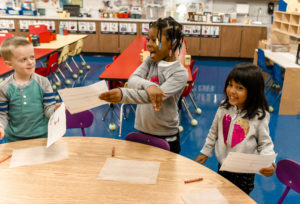When discussing multi-sensory instruction, we typically refer to visual, auditory, and tactile/kinesthetic pathways (VATK).
Some students might have strengths or preferences toward one pathway. However, using more than one modality will help students better retain information, according to the research of Dr. Samuel Orton.
Let’s take a closer look at how to use the different components of multi-sensory instruction.
The 3 Components of Multi-Sensory Instruction
Multi-sensory instruction can be broken down into these three components:
- Visual Learning
- Auditory Learning
- Tactile/Kinesthetic Learning
While it would be ideal to construct a lesson that incorporates all these factors, the truth is many of the best multi-sensory lessons might touch on two or three of the components at once.
According to The Ladder of Reading (Nancy Young, 2017), only 40% of learners can learn to read effortlessly or with relative ease and comprehensive instruction. That leaves 60% of all learners that benefit from explicit, systematic, multi-sensory, and sequential instruction.
Using the IMSE approach, you tap into students’ sensory learning pathways. That’s why multi-sensory learning and explicit instruction are the most concrete methods for teaching a new concept.
Multi-Sensory Instruction: Visual Learning
The visual pathway deals with the sense of sight. Students need to see visuals that show the meaning of what is being taught.

When using a visual modality, teachers may show directions written out instead of just stating the directions. Perhaps there is a slideshow or visual aid that students can view while teachers are speaking. When preparing for a lesson, create an accompanying handout the students can follow along with.
Teachers can use charts, flashcards, graphs, diagrams, lists, and maps when teaching.
A few more methods to help activate the visual pathway is to include using pictures, using visual cues to alert students of important information, and providing a written summary of lessons.
Multi-Sensory Instruction: Auditory Learning
The auditory pathway refers to the sense of hearing. This includes reading aloud to the child and explaining ideas out loud. Instead of just providing written directions, also read the directions.
It helps to create lesson plans that incorporate a social element. This can include paired reading, group work, experiments, projects, performances, and oral reports.
Some additional methods to activate the auditory pathway include lectures, mnemonic devices, and small group conversations about the material. You can use rhymes, beats, or songs to reinforce information. It can also be beneficial to record your lessons so students can go back and listen to it more than once.
Multi-Sensory Instruction: Kinesthetic/Tactile Learning
The tactile component refers to fine motor movement, whereas kinesthetic involves gross body movement. Tactile instruction incorporates the usage of hands to do something such as manipulating objects that represent a concept.
Kinesthetic instruction involves moving in order to focus and learn.

The main difference between the two strategies is tactile components focus on fine motor movements while kinesthetic components focus on whole-body movements. So, while arm tapping would be a kinesthetic strategy, finger tapping is a tactile strategy.
Methods that support kinesthetic and tactile instruction include providing hands-on tools whenever possible, giving breaks to allow students to move around, using the outdoors, and teaching concepts through games and projects.
Even if you’ve already taught a lesson using auditory and visual elements, it can be extremely beneficial to reinforce that information through dance, play, or role-play activities.
Additional Activities for Multi-Sensory Instruction
IMSE Three-Part Drill: The Three-Part Drill incorporates visual, auditory, and kinesthetic components. The visual component is when the teacher shows a card with a grapheme, and the students must say the phoneme. The auditory and kinesthetic part of the drill comes when students listen to a phoneme and then write the grapheme in the sand.
Vowel Intensive: The vowel intensive activity has students look at a vowel tent or stick (visual), listening for a vowel sound (auditory), and picking up a vowel tent or stick (tactile and kinesthetic).
Red Words: When working on Red Words, have your students arm tapping (kinesthetic) and finger tracing (tactile)
Everyone Benefits From Multi-Sensory Instruction
When teachers and educators introduce new material using multiple channels (senses), they effectively cater to a wider audience of learners. Our brains have evolved to learn and grow in a multi-sensory environment.
It is every classroom’s goal and responsibility to effectively teach each student. Multi-sensory instruction does exactly that and it is much more accessible to students with learning differences.
Using multiple senses gives all learners more ways to connect with what’s being taught.
IMSE believes that all children should be able to read. To achieve this end, IMSE wants to bring Orton-Gillingham to all educators to give children the best literacy instruction possible.
Learn more about what you can do to improve literacy for all using the Institute for Multi-Sensory Education’s Orton-Gillingham training.
Please connect with us on Facebook, Twitter, and Pinterest to get tips and tricks from your peers and us. Read the IMSE Journal to hear success stories from other schools and districts, and be sure to read the OG Weekly email series for refreshers and tips.
